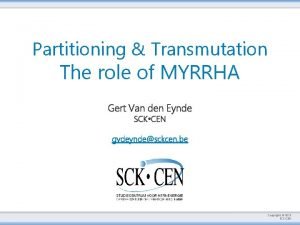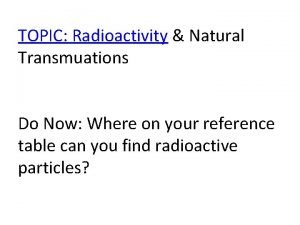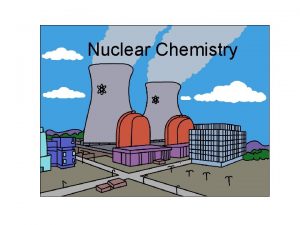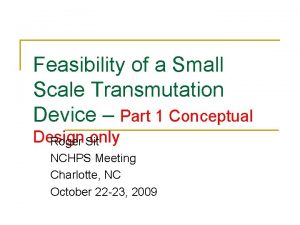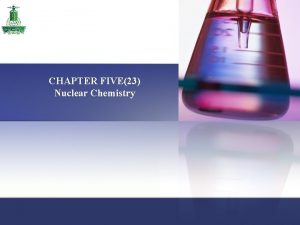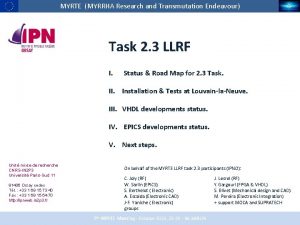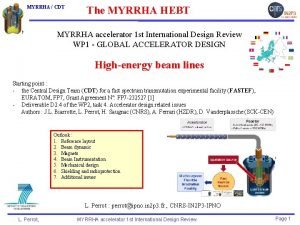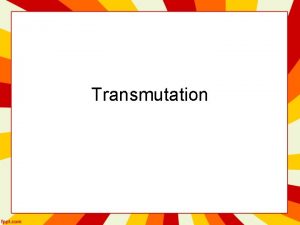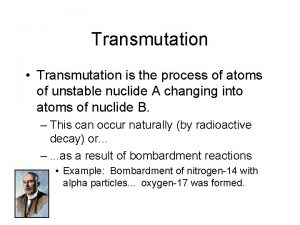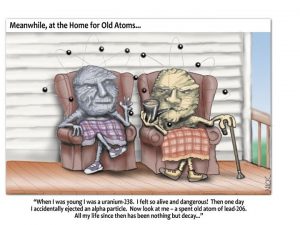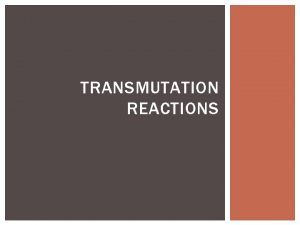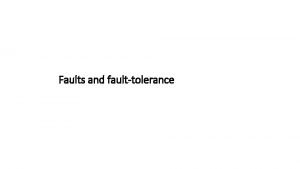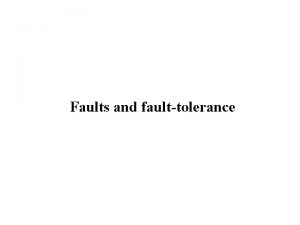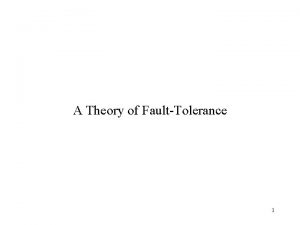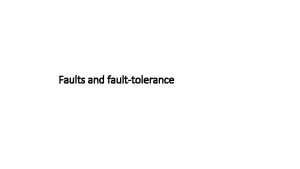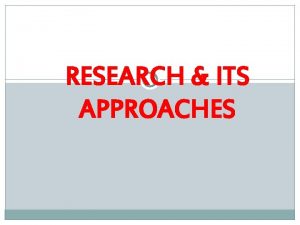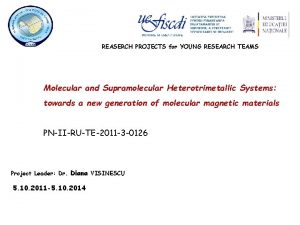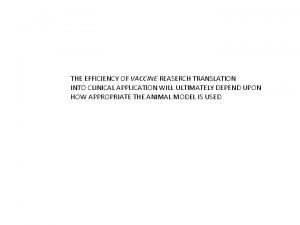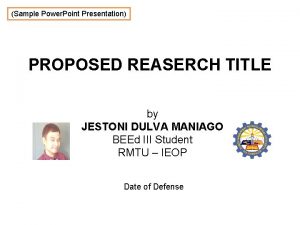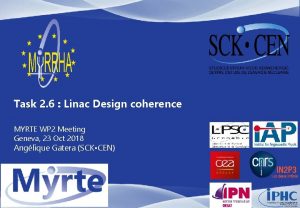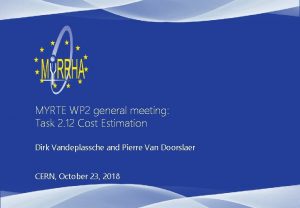MYRTE MYRRHA Reaserch Transmutation Endavour FaultTolerance in the




















- Slides: 20

MYRTE MYRRHA Reaserch & Transmutation Endavour Fault-Tolerance in the MYRRHA Superconducting Linac Workshop: Reliability of Accelerators for ADS Prévessin-Moëns (CERN), Monday 22 June 2015 F. Bouly (LPSC/IN 2 P 3/CNRS)

MYRRHA Reliability Requirements Demonstrate the ADS Concept & Transmutation Coupling : Accelerator + spallation source + subcritical reactor High power proton beam (up to 2. 4 MW) Extreme reliability Avoid beam trips longer than 3 seconds to minimise thermal stresses and fatigue on target, reactor & fuel assemblies and to ensure 80 % availability (reactor re-start procedures). Actual Specification : Less than 10 trips per 3 -month operation cycle. 22 June 2015 Faut-Tolerance in the MYRRHA SC linac - Workshop: Reliability of accelerators for ADS - F. Bouly 2

Reliability Guideline & Linac Layout In any case, reliability guidelines are needed for the ADS accelerator design: Robust design i. e. robust optics, simplicity, low thermal stress, operation margins… Redundancy (serial where possible, or parallel) to be able to tolerate/mitigate failures Repairability (on-line where possible) and efficient maintenance schemes Layout of the MYRRRHA linac Parallel redundancy Serial redundancy 22 June 2015 Faut-Tolerance in the MYRRHA SC linac - Workshop: Reliability of accelerators for ADS - F. Bouly 3

Fault Compensation Strategy: SC Linac A failure is detected anywhere Beam is stopped by the MPS in injector at t 0 The fault is localised in a SC cavity RF loop Need for an efficient fault diagnostic system New V/φ set-points are updated in cavities (cryomodule) adjacent to the failed one Set-points determined in advance: via virtual accelerator application and/or during the commissioning phase The failed cavity is detuned (to avoid the beam loading effect) Need an efficient Cold Tuning System Once the steady state is reached: the beam is resumed at t 1 < t 0 + 3 sec Failed RF cavity system to be repaired on-line if possible 22 June 2015 Faut-Tolerance in the MYRRHA SC linac - Workshop: Reliability of accelerators for ADS - F. Bouly 4

Strategy Choices & Linac Design Consequences RF Power & Accelerating Gradient overhead needed: 30 % Margin on Eacc chosen (EUROTRANS FP 6) Considered MTBF for RF System units : 10 000 hours. Leads to a Global MTBF for RF units of 70 hours. At maximum 25 % the total number of cavities can fail during the ADS operation cycle. Idea : locally compensate the failures, local matching capabilities are needed. Overcost on the linac compared to a conventional design Guidelines for the longitudinal beam dynamics design 1. Keep phase advance at zero-current σL 0 < 90° / lattice → GOAL = avoid space charge driven parametric resonances & instabilities in mismatched conditions → Implies limitations on Eacc 2. Provide high longitudinal acceptance → GOAL = avoid longitudinal beam losses & easily accept fault conditions → Implies low enough synchronous phases (φs= -40° at input, keep φs< -15°) & to keep constant phase acceptance through the linac; especially at the frequency jump 3. Continuity of the phase advance per meter (< 2°/m) → GOAL = minimise the potential for mismatch and ensure a current independent lattice → Implies especially limitations on Eacc at the frequency jump 22 June 2015 Faut-Tolerance in the MYRRHA SC linac - Workshop: Reliability of accelerators for ADS - F. Bouly 5

Linac Design and Acceptance 6 Transverse rules : smooth phase advance matching, avoid resonances and emittances exchange… J-L. Biarrotte et al. , Proc. SRF 2013 Transverse acceptance: Ø tube / RMS envelope > 15 Longitudinal acceptance: Up to 50 times nominal RMS emittance 22 June 2015 Faut-Tolerance in the MYRRHA SC linac - Workshop: Reliability of accelerators for ADS - F. Bouly

Main Parameters & Lattice Section # Einput (Me. V) Eoutput (Me. V) Cav. technology Cav. freq. (MHz) Cavity geom. β Cavity optim. β Nb of cells / cav. Focusing type Nb cav / cryom. Total nb of cav. Nominal Eacc (MV/m) * Synch. phase (deg) Beam load / cav (k. W) Nom. Qpole grad. (T/m) Section length (m) #1 #2 17. 0 80. 8 184. 2 Spoke Elliptical 352. 2 704. 4 0. 35 0. 47 0. 375 0. 510 2 5 NC quadrupole doublets 2 2 48 34 6. 4 8. 2 -40 to -18 -36 to -15 1. 5 to 8 2 to 17 #3 183. 9 600. 0 5. 1 to 7. 7 4. 8 to 7. 0 5. 1 to 6. 6 73. 0 63. 9 100. 8 Section #1 : 2 * spoke (βopt =0. 375) / cryomodule 0. 65 0. 705 5 4 60 11. 0 14 to 32 *Eacc is given at βopt normalised to Lacc = Ngap. β. λ/2 Section #2 : 2 * 5 -cell elliptical (βopt =0. 51) / cryomodule Replacement with spoke (ESS design ) to be studied Section #3 : 4 * 5 -cell elliptical (βopt =0. 705) / cryomodul J-L. Biarrotte et al. , Proc. SRF 2013 22 June 2015 7 Faut-Tolerance in the MYRRHA SC linac - Workshop: Reliability of accelerators for ADS - F. Bouly

Retuning Feasibility & Beam Dynamics First Goal : carry out preliminary retuning studies Evaluate the retuning feasibility and critical scenario (transitions between two cavity sections, full cryomodule loss…) Quantify requirement for the RF technologies Keep as best as possible the acceptance in the retune area (smooth phase advance, low synchronous phase…) Simulations achieved with Trace. Win code Several strategies with “DIAG” functions have been tested Rem : More and different diagnostics than what we will have on the real accelerator 22 June 2015 Faut-Tolerance in the MYRRHA SC linac - Workshop: Reliability of accelerators for ADS - F. Bouly 8

How is it done in Trace. Win? Errors function to set Eacc= 0 in the cavity ADJUST command is used to find the retuned cavity set points, in relative to the initial one: Factor on the field map amplitude Advance or delay on the RF phase Diagnostics to recover the energy, the phase, the beam size and the Twiss parameters Calculations are long and need several adjustments before converging to an acceptable solutions 22 June 2015 Faut-Tolerance in the MYRRHA SC linac - Workshop: Reliability of accelerators for ADS - F. Bouly 9

Studied Scenarios Several critical scenarios individually studied The main conclusion was : the fault-recovery scheme is a priori feasible everywhere in the MYRRHA SC linac to compensate the failure of a single cavity or even of a full cryomodule Most advanced scenario with multiple failures simulated at the end of the MAX project: Section #1 : 1 failed spoke cavity → 4 compensation cavities Section #2 : 1 failed cryomodule → 8 compensation cavities section #3 : 1 failed 5 -cell cavity → 4 compensation cavities 22 June 2015 Faut-Tolerance in the MYRRHA SC linac - Workshop: Reliability of accelerators for ADS - F. Bouly 10

Multiple Failures Scenario (1) : Beam envelope Input beam from injector simulation MEBT Section #1: Spoke (βopt =0. 51) 22 June 2015 Section #2: 5 -cell (βopt =0. 51) Section #3: 5 -cell (βopt =0. 51) Faut-Tolerance in the MYRRHA SC linac - Workshop: Reliability of accelerators for ADS - F. Bouly 11

Multiple Failures Scenario (2) : compensation settings Max. Eacc increase : 30 % 22 June 2015 Max. фs change : 56 % Faut-Tolerance in the MYRRHA SC linac - Workshop: Reliability of accelerators for ADS - F. Bouly 12

Multiple Failures Scenario (3) : Phase Advance & Acceptance Nominal Fault compensation 22 June 2015 Faut-Tolerance in the MYRRHA SC linac - Workshop: Reliability of accelerators for ADS - F. Bouly 13

Error Study with the fault-compensation scenario (1) Error study on the nominal MYRRHA linac : No significant losses An error study have been carried out on the multiple failure scenario Static and dynamic errors taken into account in Trace. Win Simulation from the RFQ output to the SC linac output 1000 linacs simulated with 106 macro-particles : significant longitudinal losses D. Uriot et al. , MAX project deliverable 1. 4 22 June 2015 Faut-Tolerance in the MYRRHA SC linac - Workshop: Reliability of accelerators for ADS - F. Bouly 14

Error Study with the fault-compensation scenario (2) In the last section the losses reach the acceptable limit of 1 W/m Worst case Longitudinal acceptance is the key point for beam loss control Emittance growth too important in section #2 : failed cryomodule Average over the 1000 linacs simulated D. Uriot et al. , MAX project deliverable 1. 4 22 June 2015 Faut-Tolerance in the MYRRHA SC linac - Workshop: Reliability of accelerators for ADS - F. Bouly 15

Improving the Fault-Compensation method ? The retuning calculations were done with an “internal” matching algorithm of the Trace. Win code “Black-Box” The optimisation criteria and used diagnostics may not be relevant Can we find other settings which less affect the acceptance and the emittance? Is it possible to find/define a “systematic methodology”, in view of the development of a retuning tool that can be applied on the real machine? Consideration over the retuning area: one example with one failed cavity End of the retuning area Beginning of the retuning area 22 June 2015 Faut-Tolerance in the MYRRHA SC linac - Workshop: Reliability of accelerators for ADS - F. Bouly 16

Cavity Transfer Matrix & Phase Advance 17 Cavity Longitudinal transfer matrix (1 st order) – with the approximation Δβ<<β → β ≈ cste The transverse focussing is also linked to k 1 st criterion: recover the same transfer matrix of the retuned area than in nominal condition In this case 4 non-linear equations, 4 unknowns (ki) Find the best compromise on ki (optimisation routine – matlab fuction ‘lsqnonlin’: solves nonlinear leastsquares problems ) 22 June 2015 Faut-Tolerance in the MYRRHA SC linac - Workshop: Reliability of accelerators for ADS - F. Bouly

Energy Gain & time of flight 18 2 nd criterion: the total Energy gain should remain the same than in the nominal case 3 rd criterion: the time of flight should remain the same than in the nominal case Assumption on the cavity time of flight: Problem can be solved by optimization of βi (ΔWi , ki) (Eacc, фs ) (Amplitude increase, ϕRF ) The solution with the simplified model is injected into the Trace. Win model for fine/adjustments tuning of the solutions 22 June 2015 Faut-Tolerance in the MYRRHA SC linac - Workshop: Reliability of accelerators for ADS - F. Bouly

Example result : first try! First optimisation: directly with Trace. Win With preoptimisation W O PR RK OG IN RE SS 22 June 2015 Faut-Tolerance in the MYRRHA SC linac - Workshop: Reliability of accelerators for ADS - F. Bouly 19

Final Remarks 20 The adopted Fault-compensation scheme enables a very local retuning of the linac In principle it can be applied on the whole SC accelerator Multiple failures can be compensated The retuning affects the longitudinal acceptance and can create important emittance growth Non-acceptable beam losses, especially on a real (“non-perfect”) machine A retuning algorithm has to be developed &optimised for an application to the real accelerator Work in progress – one of the goals within the MYRTE (Virtual Accelerator) The Fault compensation scheme is effective, but only if the linac has an intrinsic optimised reliability Diagnostics - High performant SC cavities (no multipacting)- Fast tuning system- RF power margin of 70 % required Other solutions to explore in the MYRTE project Linac design adjustment : more compact lattice? Lower emittance from inj. ? How to increase the acceptance? Global re-phasing of the linac after a failure: is it more simple ? n tio a t n ese r p t Relax the constraints for the compensation cavities: use more cavities ? nex goi i e t i e P S According to reliability studies the number of trips should not be as high as initially foreseen by A. 22 June 2015 Faut-Tolerance in the MYRRHA SC linac - Workshop: Reliability of accelerators for ADS - F. Bouly
 Myrrha transmutation
Myrrha transmutation Unstable nucleus
Unstable nucleus Spontaneous transmutation
Spontaneous transmutation Artificial transmutation equation
Artificial transmutation equation Natural vs artificial radioactivity
Natural vs artificial radioactivity Grade transmutation
Grade transmutation Transmutation device
Transmutation device Artificial transmutation equation
Artificial transmutation equation Determine each nuclear transmutation : 55fe → 55mn
Determine each nuclear transmutation : 55fe → 55mn Natural transmutation example
Natural transmutation example Voi kéo gỗ như thế nào
Voi kéo gỗ như thế nào Môn thể thao bắt đầu bằng chữ f
Môn thể thao bắt đầu bằng chữ f Sự nuôi và dạy con của hươu
Sự nuôi và dạy con của hươu điện thế nghỉ
điện thế nghỉ Một số thể thơ truyền thống
Một số thể thơ truyền thống Thế nào là sự mỏi cơ
Thế nào là sự mỏi cơ Trời xanh đây là của chúng ta thể thơ
Trời xanh đây là của chúng ta thể thơ Ng-html
Ng-html Số nguyên tố là số gì
Số nguyên tố là số gì Thiếu nhi thế giới liên hoan
Thiếu nhi thế giới liên hoan Fecboak
Fecboak
